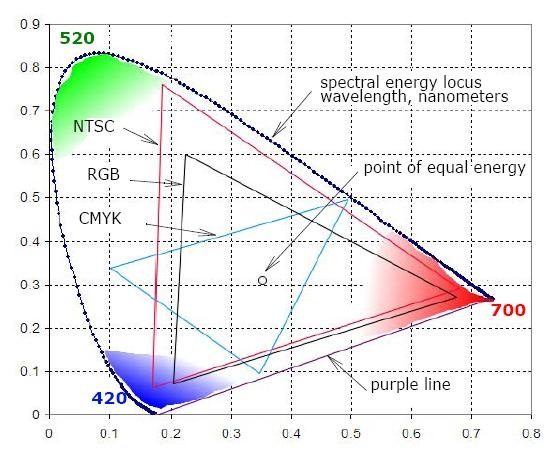Visible to Intel only — GUID: GUID-6D315F0B-EFA0-4D58-84CE-DCEE3D21F880
Visible to Intel only — GUID: GUID-6D315F0B-EFA0-4D58-84CE-DCEE3D21F880
CIE Chromaticity Diagram and Color Gamut
Figure CIE xyY Chromaticity Diagram and Color Gamut presents a diagram of all visible colors. It was developed as a result of the experimental investigations performed by CIE (International Commission on Illumination, http://members.eunet.at/cie). The diagram presents visible colors as a function of x (red) and y (green) components called chromaticity coordinates. Positions of various spectrum colors (from violet to red) are indicated as the points of a tongue-shaped curve called spectrum locus. The straight line connecting the ends of the curve is called the purple line. The point of equal energy represents the CIE standard for white light. Any point within the diagram represents some mixture of spectrum colors. The pure or fully saturated colors lie on the spectrum locus. A straight-line segment joining any two points in the diagram defines all color variations that can be obtained by additively combining these two colors. A triangle with vertices at any three points determine the gamut of colors that can be obtained by combining corresponding three colors.
The structure of the human eye that distinguishes three different stimuli, establishes the three-dimensional nature of color. The color may be described with a set of three parameters called tristimulus values, or components. These values may, for example, be dominant wavelength, purity, and luminance, or so-called primary colors: red, green, and blue.
The chromaticity diagram exhibits that the gamut of any three fixed colors cannot enclose all visible colors. For example, Figure CIE xyY Chromaticity Diagram and Color Gamut shows schematically the gamut of reproducible colors for the RGB primaries of a typical color CRT monitor, CMYK color printing, and for the NTSC television.
